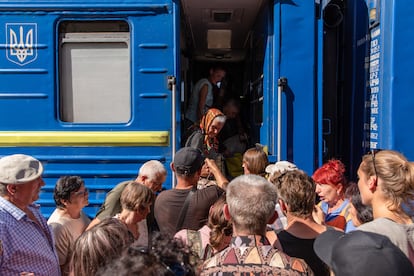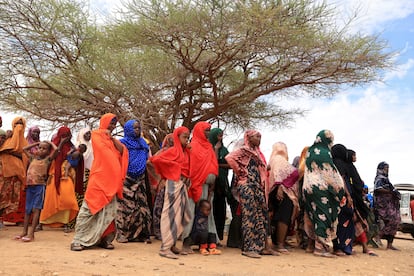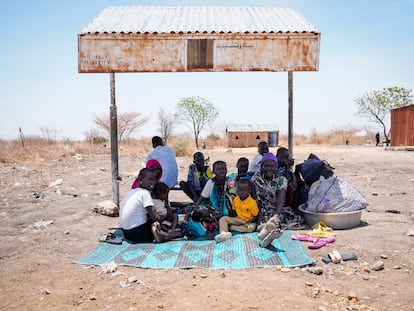Ukraine war contributes to global record of 108 million forcibly displaced people in 2022
One out of every 74 people in the world have been forced to leave their homes due to violence, persecution and natural disasters, according to UNHCR

Wars and political persecution, in addition to climatic and economic factors, force many people around the world to flee their homes. This was the case for 108.4 million people last year, the highest number ever recorded and twice as many as 10 years ago, according to the latest report by the United Nations High Commissioner for Refugees (UNHCR), published on Wednesday. Persecutions, conflicts, violence, human rights violations, and events that seriously disrupted public order all contributed a new record high of forcibly displaced persons worldwide. In the previous period analyzed the figure stood at 89.3 million, but the trend has been on the rise for a decade and the past year has witnessed the largest-ever year-on-year increase recorded.
The main reason for this increase is the Russian invasion of Ukraine, which has already forced 11.6 million people to cross the country’s borders. But there were also other large population movements due to armed conflicts elsewhere in the world, mainly in the Democratic Republic of Congo, Ethiopia, and Myanmar. The number of Afghan refugees in Iran and Pakistan was also higher than in previous years, at 5.7 million. However, in this case the increase was not due to significant numbers of new arrivals but the fact the two host countries conducted a new, more precise count, and were able to calculate the figures more accurately.
According to the annual Global Trends Report, Moscow’s invasion of Ukraine has resulted in the “fastest and one of the largest” displacement crises since World War II. Data collected show that during the early days of the war, which began on February 24, 2022, more than 200,000 refugees a day fled to other countries, mainly Ukraine’s European neighbors. By the end of last year, 11.6 million Ukrainians had been forcibly displaced: 5.9 million inside Ukraine and 5.7 million abroad.
The most recent Global Trends Report mainly covers 2022, although it contains some references to events of 2023 such as the crisis in Sudan while analyzing the movements and whereabouts of refugees, internally displaced persons, asylum seekers and stateless persons. During the first five months of 2023, forced displacement has continued to rise. UNHCR estimates that the global figure is likely to have exceeded 110 million people by the end of May this year. “New data shows that the situation is becoming increasingly dire. Overall, we estimate that around one in 74 people worldwide were forcibly displaced at the end of last year,” says Matthew Saltmarsh, a UNHCR spokesperson. To compare that number to a country, it is roughly equivalent to the entire population of the Philippines, or the combined populations of France and Spain.
Another reason that could explain the new record, especially in terms of individual asylum claims, is the relaxation of lockdown rules imposed during the Covid-19 crisis. “During the pandemic, it was more difficult for people to travel because there were more restrictions. And since these came to an end, it is much easier to move around,” notes Saltmarsh.

Sudan humanitarian aid “difficult, expensive and complicated”
The most immediate and worrying issue is the armed conflict in Sudan. Triggered in mid-April following the outbreak of clashes between the Sudanese regular army and the paramilitary Rapid Support Forces, it has forced an exodus from the country of 500,000 people and the internal displacement of a further 1.5 million. These numbers are growing every day. Similar situations can be found all over the world: in Latin America, on the borders of Europe, and in Africa from the Sahel to the Horn of Africa. In the Middle East, Syria remains a source of concern and in Asia, UNHCR cites Afghanistan on the one hand and Bangladesh on the other, where a million members of Myanmar’s Rohingya minority are living in camps on the border between the two countries.
Population movements caused by new conflicts make the headlines, but those that are more protracted in time, such as those in Syria and Yemen, or the prolonged political crisis in Venezuela, also remain in UNHCR’s spotlight. Another trend that is repeated on a yearly basis is that low and middle-income countries take in the largest numbers of displaced persons: 76% of the total. “Sometimes you hear people say, especially in the West, that all the refugees are heading that way. But, according to the data, that is not the reality,” says Saltmarsh, who also adds that surveys show that most refugees would choose to return to their home countries if they could.
Poverty in the countries with the highest arrival rates has an impact on the local population, warns the UNHCR spokesperson. “Many parts of the world face economic hardships, inflation, food shortages [...] It is increasingly difficult to support displaced people and at the same time achieve positive economic outcomes for the local population.” And he believes that the international community is falling short. “Many of our operations around the world are chronically underfunded. We are seeing this in Sudan particularly, where logistically, it is very difficult, expensive, and complicated to get the necessary humanitarian aid in.”
In this regard, Saltmarsh praises the agreement reached last week by the European Union that will oblige the bloc’s 27 member states to accept a quota of refugees or pay €20,000 for each person they refuse to take in. “It looks like a positive step. What we have been encouraging Europe to do for some years now is for all countries in the region to support the reception of refugees and to work together in a coherent way to improve asylum systems.”
Latin America
By the end of 2022, 800,600 refugees and 5.2 million other people in need of international protection were residing in the Americas, the majority of them Venezuelans, a figure that reflects a 17% increase over 2021, largely due to updated estimates of the number of asylum seekers in Colombia, which increased by 611,500, and Peru, where the number rose by 178,400. Colombia (2.5 million), Peru (976,400) and Ecuador (555,400) host the largest populations of refugees and other persons in need of international protection in the region.

Natural disasters
In recent years, there has been a proliferation in both natural disasters and climate-induced or climate-related crises that have forced entire communities to move within and across borders, often to the poorest and least-resourced places in the world. One example is Africa’s Sahel region, where climate emergencies have exacerbated localized conflict and persecution. Another is the severe flooding in Pakistan, which affected millions of people and has had a long-lasting impact. In early 2023, there was the devastating earthquake in Turkey and Syria.
This analysis also coincided with the latest report by the Internal Displacement Monitoring Center (IDMC), published a month ago. The NGO study focuses exclusively on internally displaced persons, i.e. people who are forced to flee their homes in search of safety but remain in their country of origin. Of the 71 million people in this category counted by the IDMC, 8.7 million were displaced by climate-related disasters, a much smaller number than those fleeing violence and war, but one that is growing every year.
Last year, the climate phenomenon that resulted in the highest numbers of displaced persons was La Niña, which caused floods that triggered huge population movements in Mozambique, China and Pakistan: a total of 8.6 million people. La Niña also caused droughts in Somalia, Ethiopia, and Kenya, forcing 2.1 million people to move elsewhere in search of water.
Sign up for our weekly newsletter to get more English-language news coverage from EL PAÍS USA Edition
Tu suscripción se está usando en otro dispositivo
¿Quieres añadir otro usuario a tu suscripción?
Si continúas leyendo en este dispositivo, no se podrá leer en el otro.
FlechaTu suscripción se está usando en otro dispositivo y solo puedes acceder a EL PAÍS desde un dispositivo a la vez.
Si quieres compartir tu cuenta, cambia tu suscripción a la modalidad Premium, así podrás añadir otro usuario. Cada uno accederá con su propia cuenta de email, lo que os permitirá personalizar vuestra experiencia en EL PAÍS.
¿Tienes una suscripción de empresa? Accede aquí para contratar más cuentas.
En el caso de no saber quién está usando tu cuenta, te recomendamos cambiar tu contraseña aquí.
Si decides continuar compartiendo tu cuenta, este mensaje se mostrará en tu dispositivo y en el de la otra persona que está usando tu cuenta de forma indefinida, afectando a tu experiencia de lectura. Puedes consultar aquí los términos y condiciones de la suscripción digital.
More information
Archived In
Últimas noticias
Trump claims peace in Ukraine is near, but Moscow suggests otherwise
A survivor’s account of the Interoceanic Train accident: ‘We were scared because of the speed on the curve’
The Interoceanic Train, the Mexican alternative to the Panama Canal
What is known about the Interoceanic Train derailment in Oaxaca
Most viewed
- Oona Chaplin: ‘I told James Cameron that I was living in a treehouse and starting a permaculture project with a friend’
- Reinhard Genzel, Nobel laureate in physics: ‘One-minute videos will never give you the truth’
- Why the price of coffee has skyrocketed: from Brazilian plantations to specialty coffee houses
- Pablo Escobar’s hippos: A serious environmental problem, 40 years on
- Chevy Chase, the beloved comedian who was a monster off camera: ‘Not everyone hated him, just the people who’ve worked with him’










































